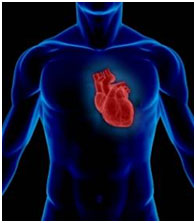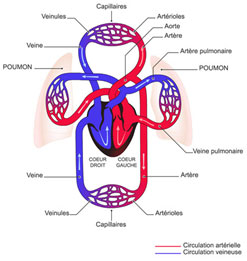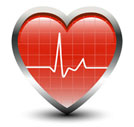What is the heart ?
The heart a mechanism of high precision
The heart: Formula 1 of the cardio-vascular system

The heart is situated in the thoracic region, having the size of a fist and is situated between two lungs, it is a muscle of ca. 300 grams for an adult. The two thin membranes, which protect the heart are the epicardium (outside envelope) and the endocardium (inner envelope).
From its bottom, two big blood vessels are descending :
- The pulmonary artery, which is the link to the two lungs
- The aorta, which is the link to the rest of the body: noble organs, viscera, muscles, tissues
The heart, a hollow organ, contains 2 totally separated parts, directly adjacent to one another:
- The « left heart »
- The « right hear »
The cardiovascular system
 The cardiovascular system consists of the heart and the blood vessels. The blood is circulating in all the organism by a network of blood vessels, powered by the heart. There are three types of vessels : the arteries, the capillaries and the veins, which are transporting the blood. The contractions of the heart bring the blood from the heart to all regions of the organism. The capillaries, mini vessels, allowing the exchange between the blood and the cells, thanks to their extremely thin lining. The blood is then brought back to the heart by the veins.
The cardiovascular system consists of the heart and the blood vessels. The blood is circulating in all the organism by a network of blood vessels, powered by the heart. There are three types of vessels : the arteries, the capillaries and the veins, which are transporting the blood. The contractions of the heart bring the blood from the heart to all regions of the organism. The capillaries, mini vessels, allowing the exchange between the blood and the cells, thanks to their extremely thin lining. The blood is then brought back to the heart by the veins.
The brain: our greatest blood consumer
The brain uses one fourth of the blood volume, pumped through the organism by the heart because it needs a lot of oxygen and of energy to function permanently. And indeed, because without this permanent flow of blood from the heart, the nerve cells of the brain would die.
Blood pressure
The blood pressure or arterial pressure is the height of pressure within the arteries. And indeed, the arteries have the role of nursing the organism. This is by bringing the blood from the heart to the different tissues of the organism and giving the cells the oxygen. The blood is chases heavily from the hollow caves of the heart at every contraction of the heart and is then propelled in the conducts. To correctly follow their role the conducts have not to be obstructed by fatty deposits.
The cardiac frequency: a quantitative notion
 Cardiac frequency means the number of heart beats (or propulsions) in a time unit (generally one minute). This is the quantitative notion which can also be defined as cycles per seconds. PSeveral parameters can accelerate or slow down the cardiac frequency. To measure this is an important diagnostic tool.
Cardiac frequency means the number of heart beats (or propulsions) in a time unit (generally one minute). This is the quantitative notion which can also be defined as cycles per seconds. PSeveral parameters can accelerate or slow down the cardiac frequency. To measure this is an important diagnostic tool.



